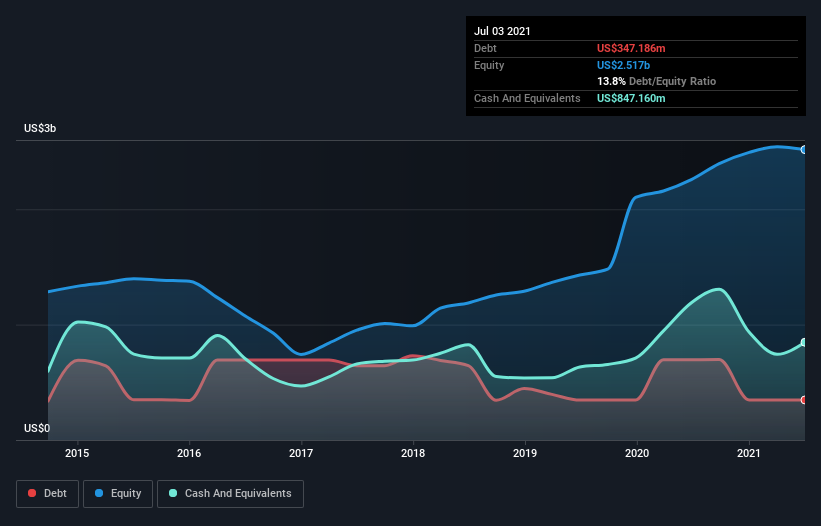Is Cadence Design Systems (NASDAQ:CDNS) Using Too Much Debt?
Howard Marks put it nicely when he said that, rather than worrying about share price volatility, 'The possibility of permanent loss is the risk I worry about... and every practical investor I know worries about.' When we think about how risky a company is, we always like to look at its use of debt, since debt overload can lead to ruin. We note that Cadence Design Systems, Inc. (NASDAQ:CDNS) does have debt on its balance sheet. But the more important question is: how much risk is that debt creating?
When Is Debt A Problem?
Debt assists a business until the business has trouble paying it off, either with new capital or with free cash flow. Part and parcel of capitalism is the process of 'creative destruction' where failed businesses are mercilessly liquidated by their bankers. However, a more frequent (but still costly) occurrence is where a company must issue shares at bargain-basement prices, permanently diluting shareholders, just to shore up its balance sheet. Of course, debt can be an important tool in businesses, particularly capital heavy businesses. When we examine debt levels, we first consider both cash and debt levels, together.
Check out our latest analysis for Cadence Design Systems
What Is Cadence Design Systems's Net Debt?
As you can see below, Cadence Design Systems had US$199.4m of debt at July 2021, down from US$696.4m a year prior. However, its balance sheet shows it holds US$847.2m in cash, so it actually has US$647.8m net cash.
How Strong Is Cadence Design Systems' Balance Sheet?
We can see from the most recent balance sheet that Cadence Design Systems had liabilities of US$926.7m falling due within a year, and liabilities of US$679.1m due beyond that. Offsetting this, it had US$847.2m in cash and US$396.0m in receivables that were due within 12 months. So it has liabilities totalling US$362.6m more than its cash and near-term receivables, combined.
Having regard to Cadence Design Systems' size, it seems that its liquid assets are well balanced with its total liabilities. So it's very unlikely that the US$40.9b company is short on cash, but still worth keeping an eye on the balance sheet. While it does have liabilities worth noting, Cadence Design Systems also has more cash than debt, so we're pretty confident it can manage its debt safely.
In addition to that, we're happy to report that Cadence Design Systems has boosted its EBIT by 41%, thus reducing the spectre of future debt repayments. The balance sheet is clearly the area to focus on when you are analysing debt. But ultimately the future profitability of the business will decide if Cadence Design Systems can strengthen its balance sheet over time. So if you want to see what the professionals think, you might find this free report on analyst profit forecasts to be interesting.
Finally, a business needs free cash flow to pay off debt; accounting profits just don't cut it. While Cadence Design Systems has net cash on its balance sheet, it's still worth taking a look at its ability to convert earnings before interest and tax (EBIT) to free cash flow, to help us understand how quickly it is building (or eroding) that cash balance. Happily for any shareholders, Cadence Design Systems actually produced more free cash flow than EBIT over the last three years. That sort of strong cash generation warms our hearts like a puppy in a bumblebee suit.
Summing up
While it is always sensible to look at a company's total liabilities, it is very reassuring that Cadence Design Systems has US$647.8m in net cash. And it impressed us with free cash flow of US$848m, being 126% of its EBIT. So is Cadence Design Systems's debt a risk? It doesn't seem so to us. When analysing debt levels, the balance sheet is the obvious place to start. However, not all investment risk resides within the balance sheet - far from it. To that end, you should be aware of the 1 warning sign we've spotted with Cadence Design Systems .
If you're interested in investing in businesses that can grow profits without the burden of debt, then check out this free list of growing businesses that have net cash on the balance sheet.
This article by Simply Wall St is general in nature. It does not constitute a recommendation to buy or sell any stock, and does not take account of your objectives, or your financial situation. We aim to bring you long-term focused analysis driven by fundamental data. Note that our analysis may not factor in the latest price-sensitive company announcements or qualitative material. Simply Wall St has no position in any stocks mentioned.
Have feedback on this article? Concerned about the content? Get in touch with us directly. Alternatively, email editorial-team (at) simplywallst.com.

